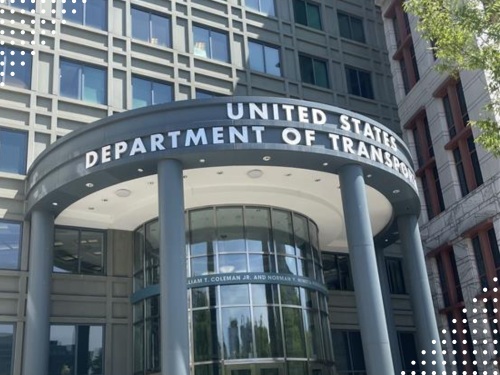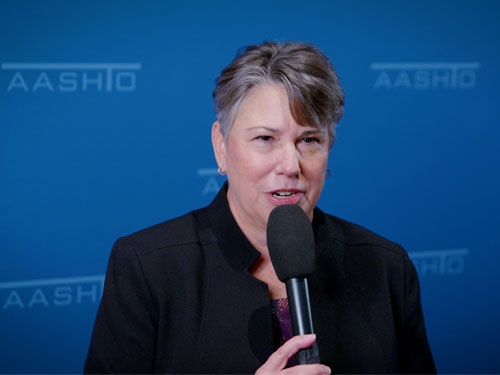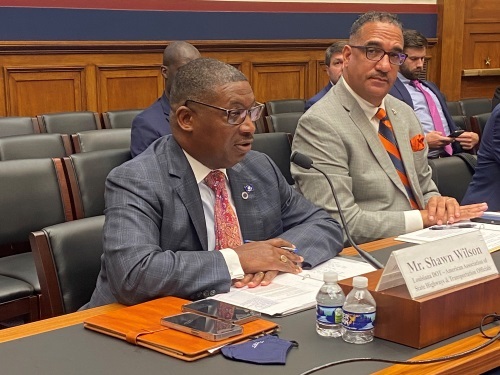Dr. Shawn D. Wilson (seen above) – secretary of the Louisiana Department of Transportation and Development and 2021-2022 president of the American Association of State Highway and Transportation Officials – believes traffic culture needs to undergo serious change in order to reverse an ongoing increase in U.S. roadway fatalities.
[Above photo by AASHTO]
Testifying at a June 8 hearing before the Subcommittee on Highways and Transit – part of the House of Representatives Committee on Transportation and Infrastructure – Wilson noted that the National Highway Traffic Safety Administration estimates that 42,915 people died in motor vehicle traffic crashes in 2021. That is a 10.5 percent increase from the 38,824 fatalities in 2020 – the highest number of fatalities since 2005, according to preliminary agency data.

“The breakdown of the data in NHTSA’s early estimates for 2021 traffic fatalities show there is no easy answer or single, one-size-fits-all solution to address this problem,” he stressed in his testimony. “Fatalities have increased on both rural and urban roads, and in both daytime and nighttime crashes. Fatalities have increased for pedestrians, bicyclists, and motorcyclists who do not have the protection of a vehicle enclosing them and absorbing some of the impact energy. Fatalities have also increased for people aged 65 and older, reversing a previous trend.”
Beyond fatalities, Wilson emphasized that “we cannot forget” that traffic crashes injure over 2.7 million people every year – and those injuries produce “lifelong physical, emotional, social, and other impacts.” Because of those trends, he said state DOTs, federal transportation agencies, and others must “aggressively implement proven roadway strategies” as well as accelerate the development of “new and innovative countermeasures and technologies” that hold promise of reducing crash fatalities and injuries in the future.
[Editor’s note: The video below contains Wilson’s opening statement at the hearing as well as his answers to questions posed by the subcommittee’s members.]
“An evolution of our traffic safety culture, both in our organizations and among road users, will help us prioritize the consideration of safety impacts in our planning and decision-making,” Wilson explained at the hearing. “All state DOTs strive to achieve zero roadway fatalities. In addition, our other public agency partners who work in behavioral traffic safety programs, passenger and commercial vehicle safety, and other disciplines have similar goals. We are all working toward the same goal of eliminating fatalities and serious injuries. This collaboration is critical to reaching our collective zero goal.”
He emphasized that AASHTO has adopted the “Toward Zero Deaths” strategic safety plan and is developing resources to support transportation and highway safety organizations’ efforts to implement proven safety countermeasures and to improve traffic safety culture.

“We are developing case studies, templates, webinars, communications materials, and utilizing other methods to share knowledge and expertise among safety organizations,” Wilson said at the hearing. “In combination with resources such as the Federal Highway Administration’s Proven Safety Countermeasures, technical support and resources, our members and transportation partners have access to a range of means for strengthening their safety activities. Similarly, other safety partners, such as the Road to Zero Coalition and the Vision Zero Network, provide opportunities for sharing of experiences, collaboration and even funding for safety activities.”
He also touted the benefits of the “Safe System Approach” when it comes to roadway infrastructure. That approach mandates the “acceptance of the shared responsibility” for preventing serious crashes and roadway fatalities by “proactively providing a transportation system that accounts for human mistakes, reduces impact energy to the human body,” and provides redundant protections for all road users.
“For example, in Louisiana, we have taken a proactive approach in reducing the potential for crossover median crashes on our high-speed divided highways,” Wilson explained. “We realize motorists can and will make mistakes which lead to roadway departure crashes when traveling at a high rate of speed. Due to the success of these pilot projects, we developed a cable median barrier installation program, which has resulted in a 33 percent reduction in cross-median crashes for these roadways.”
He added that states are identifying ways to incorporate equity into their safety analyses to boost their ability to meet individual roadway safety goals. “In Louisiana, we completed a Statewide Pedestrian Crash Assessment that identifies ‘risk factors’ such as average daily traffic, section length, population density, percent of households with no vehicle, percent of households below the poverty line, percent unemployed, median household income, distance to school, distance to park, and shoulder type,” Wilson said.
He also noted that 35 states, including Louisiana, along with Puerto Rico have adopted Complete Street policies that are establishing a “new engineering design position” to provide expertise in the design of pedestrian and bicycle facilities. “Louisiana uses a Complete Streets approach to make improvements to non-motorized facilities on all roadway projects where practicable by working with the Complete Streets Advisory Council and our state legislature,” Wilson said.
“In summation, every state DOT in the nation and the AASHTO community stand with this committee in your unwavering commitment to do everything in our power to make our roads safer,” he said. “As infrastructure owners and operators, state DOTs play a leading role in many of the activities that will get us to zero deaths. State DOTs are ‘all-in’ on improving the safety of our transportation system for all users.”
 Top Stories
Top Stories
USDOT Makes $1.5B Worth of BUILD Grants Available
December 19, 2025 Top Stories
Top Stories

